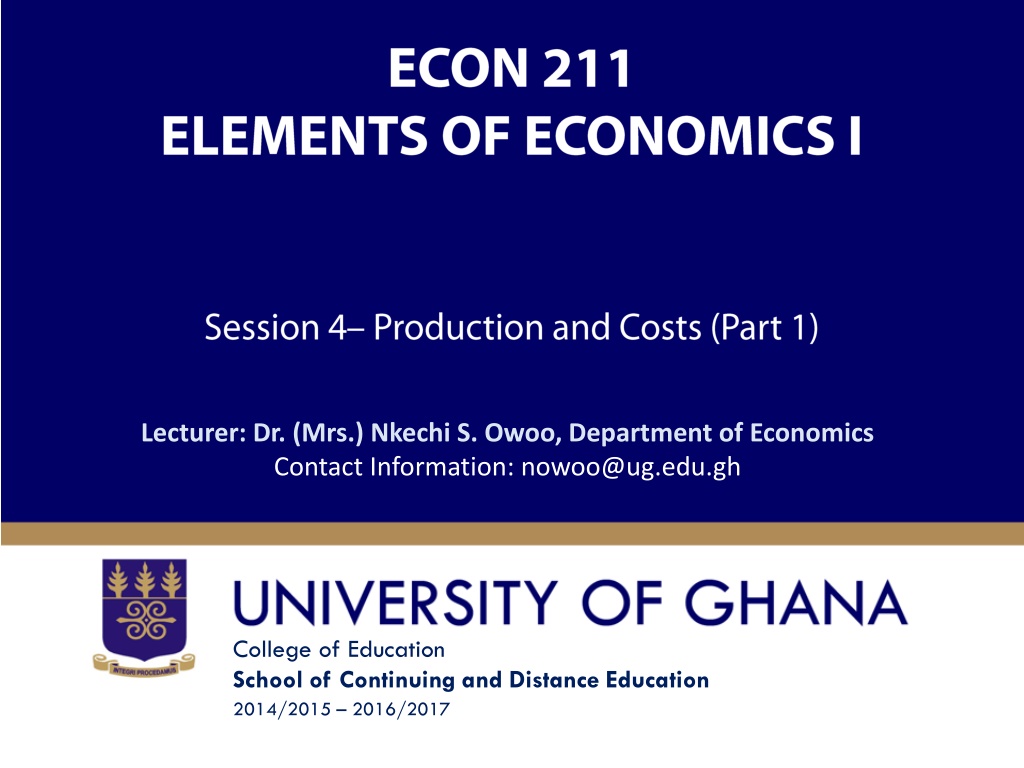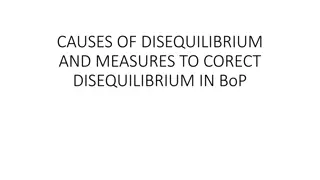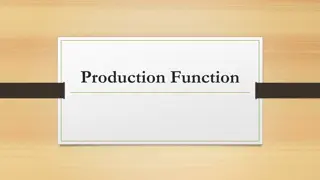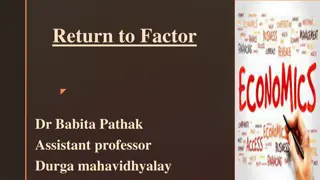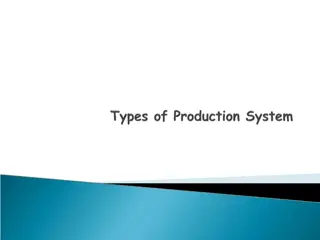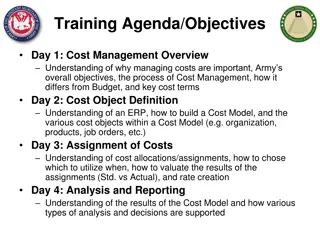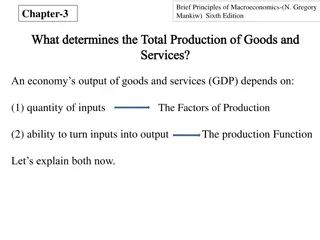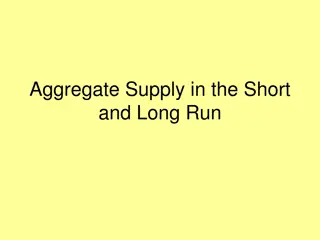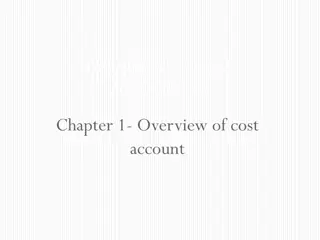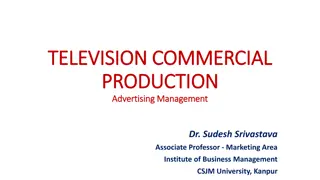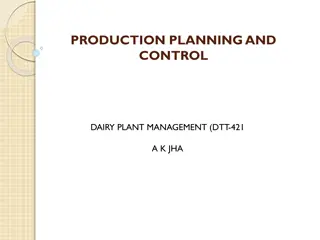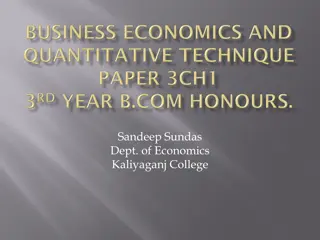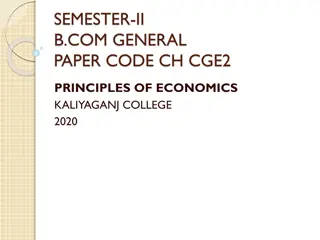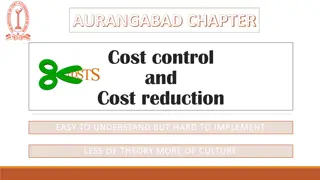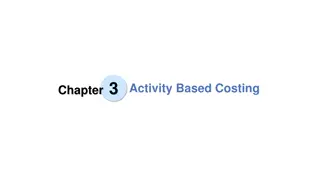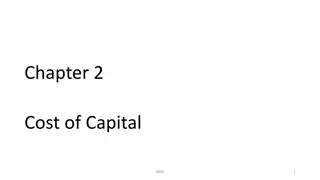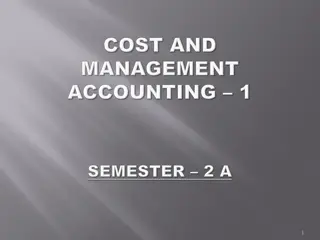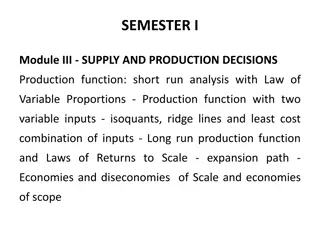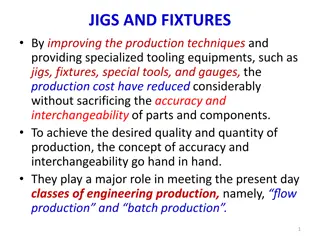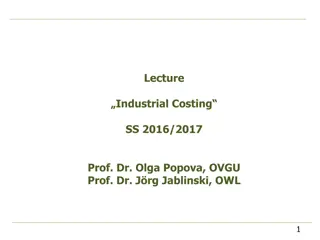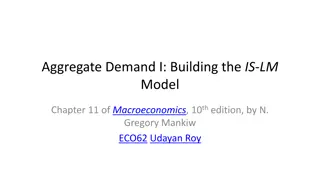Short-Run Production and Cost Concepts
This lecture by Dr. (Mrs.) Nkechi S. Owoo delves into the concept of short-run production in economics, covering topics such as total costs, averages, and marginal cost. The session outlines key topics like production in the short run, short-run costs, and provides a reading list for further understanding. It explains the production function of a firm and how inputs like capital and labor impact the output. The lecture simplifies complex production functions by focusing on firms utilizing two inputs - capital and labor.
Download Presentation

Please find below an Image/Link to download the presentation.
The content on the website is provided AS IS for your information and personal use only. It may not be sold, licensed, or shared on other websites without obtaining consent from the author.If you encounter any issues during the download, it is possible that the publisher has removed the file from their server.
You are allowed to download the files provided on this website for personal or commercial use, subject to the condition that they are used lawfully. All files are the property of their respective owners.
The content on the website is provided AS IS for your information and personal use only. It may not be sold, licensed, or shared on other websites without obtaining consent from the author.
E N D
Presentation Transcript
Lecturer: Dr. (Mrs.) Nkechi S. Owoo, Department of Economics Contact Information: nowoo@ug.edu.gh College of Education School of Continuing and Distance Education 2014/2015 2016/2017
Session Overview This session discusses a variety of other cost concepts useful for the analysis that follows, including totals (total cost, total variable cost, total fixed cost), averages (average total cost, average variable cost, average fixed cost), marginal cost, among others. We examine short-run concepts in this session. Slide 2
Session Outline The key topics to be covered in the session are as follows: Production in the Short-Run Short-run costs Slide 3
Reading List Hall and Lieberman Chapter 5 : pp: 159- 174 Slide 4
Topic One PRODUCTION IN THE SHORT RUN Slide 5
Production A business firm is an organization that specializes in production and is owned and operated by private individuals Production refers to the process of combining inputs to make goods and services What inputs will the firm need to produce a given output? An in what amounts? This question is answered by the firm s technology Technology refers to the method of combining inputs to produce goods or services At any given point in time, however, a firms technology can be regarded as given i.e. a constraint on its production This is illustrated in a firms production function 6
The Production Function A firm s production function iIndicates the maximum amount of output a firm can produce over some period of time from each combination of inputs Figure 1The Firm s Production Function Different Combinations of Inputs Different Quantities of Output Production Function 7
The Production Function When a firm uses many different inputs, production functions can be complicated In this session, to keep things simple, we assume that a firm uses only two inputs Capital Labour We analyze the production decisions of a firm- Spotless Car Wash. The firms capital consists of an automated car wash And its labour is full-time workers who drive the cars onto the line, drive them out, towel the down at the end and deal with customers When we plug in various quantities of labour (i.e. workers) and capital (i.e. automated lines) into the production function, we see how much is produced (i.e. number of cars washed) per day (before this analysis, we define short- and long- run periods for a firm on the next slide) Slide 8
Short-Run versus Long-Run Periods A firm s Long run period is a time horizon long enough for a firm to vary all of its inputs Variable inputs can be adjusted up or down as the quantity of output changes E.g. labour could be a good example of a variable input as firms can quickly hire more workers in order to increase production A firm s Short run period is a time period during which at least one of the firm s inputs is fixed Fixed inputs cannot be adjusted as output changes in the short run E.g. land or capital could be a good example of a fixed input as it may be difficult to quickly acquire additional land due to budgetary constraints or land availability. In the short run, all inputs are fixed 9
Production in the Short-Run In the short run, firms cannot do anything about their fixed inputs They are stuck with whatever quantities that they have At Spotless Car Wash, over the short run, labour is the only variable input and capital is the only fixed inputs 10
Production in the Short-Run Quantity of Capital Quantity of Labour Total Product (Cars washed per Day) 1 0 0 1 1 30 1 2 90 1 3 130 1 4 160 1 5 184 1 6 196 The three (3) choices in the table above describe Spotless Car Wash s production choices in the short-run In the short run, the firm is stuck with only one unit of capital but it can take on as many or as few workers as it wishes Column 3 shows the total product of the firm Slide 11
Production in the Short-Run Total product Maximum quantity of output that can be produced from a given combination of inputs This can be illustrated graphically The number of workers is placed on the horizontal axis The total product is drawn on the vertical axis Output increases with additional workers This is why the total product curve slopes upwards The vertical arrows indicate by how much total product increases with each additional worker This refers to the marginal product of labour Marginal product of labor: MPL= Q/ L This is the additional output produced when one more worker is hired 12
Total and Marginal Product Total and Marginal Product Units of Output Total Product 196 184 160 Q from hiring fourth worker = 30 130 Q from hiring third worker = 40 90 Q from hiring second worker = 60 30 Q from hiring first worker = 30 Number of Workers 1 6 2 4 3 5 increasing marginal returns diminishing marginal returns 13
Short-run Production Quantity of Capital Quantity of Labour Total Product (Number of dresses sewn per day) Marginal Product of labour (MPL) 1 0 0 - 1 1 30 30 1 2 90 60 1 3 130 40 1 4 160 30 1 5 184 24 1 6 196 12 MPL= Change in Quantity/ Change in Labour Why does MPL initially increase, then decrease? 14
Short run Production Increasing Marginal Returns to Labour As production increases, additional workers add more to total output Why? 15
Short run Production Increasing Marginal Returns to Labour As production increases, additional workers add more to total output Why? Workers become more specialized. Instead of one seamstress cutting dress, putting pieces together, adding trimmings, ironing finished dress, etc...task can be divvied up among different workers. 16
Short run Production Decreasing Marginal Returns to Labour As production increases, additional workers add less to total output Why? 17
Short run Production Decreasing Marginal Returns to Labour As production increases, additional workers add less to total output Why? Each worker has less and less of fixed input to work Law of Diminishing Marginal Returns As more and more of any input is added to a fixed amount of other inputs, its marginal product will eventually decline 18
Topic One SHORT-RUN COSTS Slide 19
Thinking About Costs The previous section was concerned with production i.e. the physical relationship between inputs and output A more critical concern for a firm is what it will cost to produce a given quantity of output 20
Thinking About Costs Earlier in the semester, we learnt that Economists think of costs as opportunity costs Therefore Total cost refers to the opportunity cost of the owners everything they must give up in order to produce that amount of output 21
Explicit vs. Implicit Costs From our earlier sessions, we learnt that there are two types of costs: Explicit cost Money actually paid out for the use of inputs Implicit cost The cost of inputs for which there is no direct money payment 22
Illustrations of Implicit and Explicit Costs 1. Suppose Ms Abu has opened up a restaurant in a building that she already owns Since she owns the building, she does not have to pay any rent= no explicit rental costs. Does this mean that using the building is free? To an accountant, yes. To an economist, absolutely not! Why? By using the building herself, Ms Abu sacrifices the opportunity to rent out to someone else. This foregone rent is an implicit cost Suppose that instead of borrowing money to set up the restaurant, Ms Abu uses Ghc100,000 of her own money Ms Abu is not paying any interest but there is still an opportunity cost The Ghc100,000 could have been put in a bank or lent to someone else to earn interest for her If the interest rate is 5%, every year that Ms Abu runs her restaurant, she gives up Ghc5000 in interest that she could have had This foregone interest is an implicit cost Suppose Ms Abu decided to manage the business herself By doing this, has she escaped the costs of hiring a manager? Not really, as Ms Abu could be working somewhere else and earning an income This foregone income is an implicit cost 2. 3. Slide 23
Summary of Implicit and Explicit Costs Explicit Costs Implicit Costs Rent paid out Opportunity cost of Owner s Land and Buildings (rent foregone) Interest on Loans Opportunity cost of Owner s money (investment income foregone) Managers salaries Opportunity cost of owner s time (labour income foregone) Hourly workers wages Cost of raw material Slide 24
Thinking About Costs What will it cost a firm to produce a given level of output? Why are costs important? Other part of a firm s revenue! Reducing costs increases a firm s profits. 25
The Irrelevance of Sunk Costs Sunk costs A cost that has been paid or must be paid, regardless of any future action being considered Scenario Abena just started taking Economics classes this semester. She has paid all her fees and has bought all the required textbooks for the course. Halfway through the semester, Abena realises that she is more interested in taking Geography classes. However, she has already spent time and money on her Economics class, and is reluctant to switch to Geography. What should she do? 26
The Irrelevance of Sunk Costs Sunk costs Sunk costs should not be considered when making decisions Abena should not consider the time or money spent in the Economics class, in choosing the course she would like to pursue. Only the costs that depend on her decision are relevant e.g. Additional costs of more Economics classes, costs of taking Geography as a course, penalty costs of switching courses mid-semester, etc 27
Costs in the Short-run There are two types of costs Fixed Costs Variable Costs 28
Costs in the Short-Run Fixed Costs The costs of a firm s fixed inputs, which remain constant as output changes Example is rent (input is land) Also referred to as overhead . Variable Costs The costs of variable inputs, which change with firm s output Example is wages (input is labour) 29
Measuring Short-run costs How does a change in output cause a firms inputs, and therefore its costs, to change? Add information on Spotless Car Wash costs to existing Total Product table... 30
Measuring Short run Costs Labour costs= Ghc120 per day; Capital Costs= Ghc150 per day Output (Q) Capital Labour TFC TVC TC AFC AVC ATC 0 1 0 150 0 150 - - - 30 1 1 150 120 270 5 4 9 90 1 2 150 240 390 1.67 2.67 4.33 130 1 3 150 360 510 1.15 2.77 3.92 160 1 4 150 480 630 0.94 3 3.94 184 1 5 150 600 750 0.82 3.26 4.08 196 1 6 150 720 870 0.77 3.67 4.44 31
Measuring Short-run costs- Total Costs Total Costs= Total Fixed Costs + Total Variable Costs Total Fixed Costs The cost of all inputs that are fixed Total Variable Costs The cost of all variable inputs used in producing a particular level of output Graphical Illustration 32
Total Cost Curves The Firm s Total Cost Curves Dollars TC $435 375 TVC TFC 315 255 195 135 TFC 0 30 90 130 160 184 Units of Output 33
Measuring Short-run Costs- Average Costs Average Costs Average Fixed Costs AFC= TFC/Q Always falls as output rises- spreading overhead Average Variable Costs AVC= TVC/Q Cost of variable inputs per unit of output First decreases, then increases (U- shape) Average Total Costs ATC= TC/Q Total cost per unit of output Also U-shape, but different from AVC 34
Measuring Short run Costs Labour costs= Ghc120 per day; Capital Costs= Ghc150 per day Output (Q) Capital Labour TFC TVC TC AFC AVC ATC 0 1 0 150 0 150 - - - 30 1 1 150 120 270 5 4 9 90 1 2 150 240 390 1.67 2.67 4.33 130 1 3 150 360 510 1.15 2.77 3.92 160 1 4 150 480 630 0.94 3 3.94 184 1 5 150 600 750 0.82 3.26 4.08 196 1 6 150 720 870 0.77 3.67 4.44 35
Measuring Short-run Costs Marginal Costs Change in total costs from a one-unit change in output MC= Change in Total Cost/ Change in output MC first declines, then begins to rise Related to law of diminishing marginal returns If MP is rising, then fewer additional workers needed to produce given level of output Falling MC As long as MP is rising, MC is falling, and v.versa 36
Measuring Short run Costs Labour costs= Ghc120 per day; Capital Costs= Ghc150 per day Output (Q) Capital Labour TFC TVC TC AFC AVC ATC MC 0 1 0 150 0 150 - - - 4 30 1 1 150 120 270 5 4 9 2 90 1 2 150 240 390 1.67 2.67 4.33 3 130 1 3 150 360 510 1.15 2.77 3.92 4 160 1 4 150 480 630 0.94 3 3.94 5 184 1 5 150 600 750 0.82 3.26 4.08 10 196 1 6 150 720 870 0.77 3.67 4.44 37
Average And Marginal Costs Average And Marginal Costs Dollars MC $4 3 AFC ATC 2 AVC 1 30 90 130 160 196 0 38 Units of Output
The Relationship between Average and Marginal Costs All ATC, AVC and MC curves are u-shaped MC intersects ATC and AVC at their minimums Why?
Explaining Relationship between ATC, AVC and MC curves Relationship between MC and AVC Side Illustration At low levels of output, MC falls due to increasing marginal returns As MC falls, it is lower than AVC, so pulls AVC down AVC decreases As output increases, DMR sets in and MC rises MC eventually rises above AVC, and begins to pull AVC up Hence, U-shaped AVC curve
Explaining Relationship between ATC, AVC and MC curves Relationship between MC and ATC Similar to AVC, but ATC also includes AFC And AFC always falls with increasing output At low levels of output, MC and AVC fall, but ATC falls faster When AVC starts to rise, falling AFC and rising AVC compete but eventually, ATC starts to rise Minimum ATC at higher output that minimum AVC MC intersects ATC and AVC at their minimum points
References Economics: Principles and Applications: Hall R.E. and Lieberman M. (2008), Thomson/ South Western (4th Edition) Slide 42
